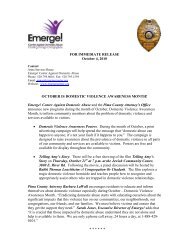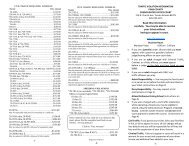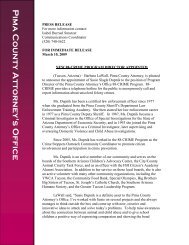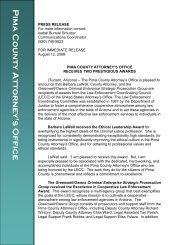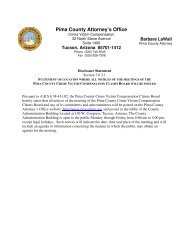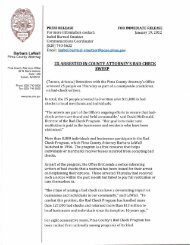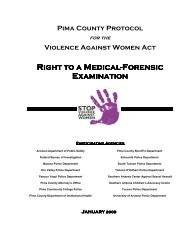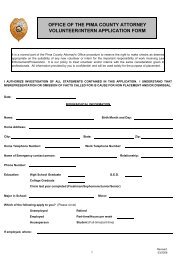Drug Treatment Alternative to Prison - Pima County Attorney
Drug Treatment Alternative to Prison - Pima County Attorney
Drug Treatment Alternative to Prison - Pima County Attorney
You also want an ePaper? Increase the reach of your titles
YUMPU automatically turns print PDFs into web optimized ePapers that Google loves.
Cost-Benefit Analysis of <strong>Pima</strong> <strong>County</strong>’s<br />
<strong>Drug</strong> <strong>Treatment</strong> <strong>Alternative</strong> <strong>to</strong> <strong>Prison</strong> (DTAP) Program<br />
Final Report<br />
Submitted <strong>to</strong>:<br />
Barbara LaWall<br />
<strong>Pima</strong> <strong>County</strong> At<strong>to</strong>rney<br />
<strong>Pima</strong> <strong>County</strong> At<strong>to</strong>rney’s Office<br />
Submitted by:<br />
Patricia M Herman, ND, PhD<br />
Senior Behavioral Scientist, RAND Corporation<br />
and<br />
Beth L. Poindexter, ND, MPH<br />
University of Arizona<br />
December 10, 2012<br />
1
Program Overview<br />
The <strong>Pima</strong> <strong>County</strong> <strong>Drug</strong> <strong>Treatment</strong> <strong>Alternative</strong> <strong>to</strong> <strong>Prison</strong> (DTAP) program is a three-year program<br />
funded by the United States Department of Justice, Office of Justice Programs, Bureau of<br />
Justice Assistance (BJA) and by the United States Department of Health and Human Services,<br />
Center for Substance Abuse <strong>Treatment</strong>, Substance Abuse and Mental Health Services<br />
Administration (SAMHSA). This funding covered two objectives with regard <strong>to</strong> reducing drug<br />
addiction and drug-related crime in <strong>Pima</strong> <strong>County</strong>. The first is <strong>Pima</strong> <strong>County</strong>’s <strong>Drug</strong> Court<br />
Enhancement program, which provides additional wrap-around recovery support services <strong>to</strong><br />
probationers in drug court.<br />
The second, and the focus of this cost-benefit analysis (CBA), is <strong>Pima</strong> <strong>County</strong>’s <strong>Drug</strong> <strong>Treatment</strong><br />
<strong>Alternative</strong> <strong>to</strong> <strong>Prison</strong> (DTAP) program. DTAP provides residential drug treatment and needsbased<br />
wrap-around recovery support services in lieu of prison <strong>to</strong> selected non-violent repeat<br />
drug offenders who are motivated <strong>to</strong> change their behaviors and for whom this is at least their<br />
third narcotics offense.<br />
Methods<br />
This report covers the results of a cost-benefit analysis of the DTAP program based upon what<br />
is known <strong>to</strong> date about its first-year participants. In brief, a CBA estimates the dollar value of<br />
both the costs and benefits of a program so that these costs and benefits can be directly<br />
compared <strong>to</strong> ascertain whether benefits exceed costs (i.e., net benefits > 0). The 20 First-Year<br />
DTAP participants included in this CBA entered the program between January 1, 2011 and<br />
November 30, 2011. Therefore, we had almost one full year of data or longer on all participants.<br />
The main CBA was conducted from the perspective of the State. This means that only costs and<br />
benefits <strong>to</strong> the State are included in this analysis—e.g., no costs paid by <strong>Pima</strong> <strong>County</strong> are<br />
included. We also calculated the costs and benefits <strong>to</strong> the criminal justice system (CJS) as a<br />
whole; these results include <strong>County</strong> costs. It should be noted that the State perspective<br />
calculated in this report does not include all possible benefits <strong>to</strong> the State. Examples of<br />
additional benefits not counted here include income taxes from DTAP completers who<br />
successfully join the workforce, reduction in Child Protective Services costs for the children of<br />
DTAP participants who are able <strong>to</strong> care for their children, and the benefits of any reductions in<br />
crime attributable <strong>to</strong> DTAP. All costs and benefits are reported as 2011 U.S. dollars and a 3%<br />
discount rate was used <strong>to</strong> adjust all future costs <strong>to</strong> baseline.<br />
Identification of a control group<br />
In order <strong>to</strong> determine the impact of having drug offenders enter the DTAP program, we must<br />
have an estimate of what would have happened <strong>to</strong> these same offenders if DTAP were not<br />
available. To accomplish this we identified a group of drug offenders in <strong>Pima</strong> <strong>County</strong> who were<br />
arrested in the period just before DTAP became available, and who were judged <strong>to</strong> have been<br />
eligible had DTAP existed at that time. We identified this control group by searching <strong>Pima</strong><br />
<strong>County</strong> court case records starting from the date just prior <strong>to</strong> the start of the DTAP program<br />
(December 31, 2010) and working backward in time until we had 50 control cases. Figure 1<br />
provides a flowchart of the requisite criteria by which an individual is determined <strong>to</strong> be eligible<br />
for DTAP. The same criteria were used <strong>to</strong> determine inclusion in the control group.<br />
2
Figure 1. Flowchart of Criteria <strong>to</strong> Determine DTAP Eligibility 1<br />
Costs and benefits included<br />
Both DTAP participants and our control group members follow the same path through the<br />
criminal justice system (CJS) until the point at which a defendant is determined <strong>to</strong> be eligible for<br />
DTAP and agrees <strong>to</strong> a plea. At this point a DTAP participant who pleads guilty <strong>to</strong> the drug<br />
charge receives three years of probation, including participation in the DTAP program. The<br />
common path through the CJS <strong>to</strong> this point includes an arrest, placement in the <strong>Pima</strong> <strong>County</strong><br />
Jail, initial appearance, release on bail or retention in jail until trial/disposition, and a case is<br />
issued. Because these costs can be assumed <strong>to</strong> be similar between groups (we test this<br />
assumption below—see Table 3), they are not included in the CBA.<br />
The costs and benefits included in this CBA begin at the point in time when the two groups<br />
deviate in their interactions with the CJS. This deviation point occurs just after those in both<br />
groups accept their pleas and the DTAP participant is transported <strong>to</strong> the residential treatment<br />
facility <strong>to</strong> begin their 90-day program while the control counterpart awaits sentencing either out<br />
of cus<strong>to</strong>dy or after being transported back <strong>to</strong> jail. Table 1 summarizes the cost components for<br />
1 (A. Floyd, e-mail communication, September 6, 2012)<br />
3
the DTAP completers, the additional costs for DTAP non-completers and cost components for<br />
the control group.<br />
Table 1. Components of the <strong>Drug</strong> <strong>Treatment</strong> <strong>Alternative</strong> <strong>to</strong> <strong>Prison</strong> (DTAP) Program for<br />
Completers, Non-Completers and the Control Group<br />
DTAP Completer Costs<br />
Additional Costs for DTAP<br />
Non-Completer<br />
Control Group Costs<br />
▪ Psychological assessments ▪ Additional court hearings ▪ Sentencing hearing<br />
▪ Residential treatment ▪ Jail time ▪ Jail time<br />
▪ Case management<br />
▪ Transportation from jail ▪ Transportation from jail<br />
<strong>to</strong> prison<br />
<strong>to</strong> prison<br />
▪ Medical ▪ <strong>Prison</strong> ▪ <strong>Prison</strong><br />
▪ Review hearings ▪ Parole ▪ Parole<br />
▪ Probation<br />
DTAP Completer Costs<br />
In order for a defendant <strong>to</strong> be admitted <strong>to</strong> the DTAP program he/she must meet the statu<strong>to</strong>ry<br />
requirements as well as the program requirements. One program requirement is no evidence of<br />
severe mental illness. As needed, external professional psychological contrac<strong>to</strong>rs are used <strong>to</strong><br />
perform the mental health screening and psychological assessments. This is a cost incurred by<br />
the DTAP program for some participants.<br />
At the point when the DTAP participant accepts the plea, he or she is immediately transported<br />
<strong>to</strong> a residential treatment facility for 90 days of care. During the residential treatment the DTAP<br />
participants do not incur probation fees. The two residential treatment facilities used for DTAP<br />
participants cost $85 per day, a contracted price between the <strong>County</strong> and the individual<br />
facilities. 2 All residential treatment costs in this evaluation are the actual costs incurred for each<br />
DTAP participant.<br />
After completion of residential treatment the DTAP participant moves <strong>to</strong> a family residence or<br />
transitional housing. Transitional housing costs and associated living expenses are included on<br />
a case-by-case basis as needed and are generally categorized by the DTAP program as Case<br />
Management costs. As an example, one DTAP participant’s transitional living expenses<br />
included $705 for housing, $452 for transportation, $120 for food, and $97 for clothing. Again, all<br />
Case Management costs are the actual costs incurred for each DTAP participant.<br />
From the time of completion of the residential treatment until graduation from the DTAP<br />
program, DTAP participants are on special probation and are required <strong>to</strong> attend DTAP review<br />
hearings in <strong>Drug</strong> Court every two weeks in order <strong>to</strong> assess progress, acknowledge sobriety<br />
anniversaries, satisfy probation requirements, and address any shortcomings or failures.<br />
2 (A. Floyd, e-mail correspondence, April, 20, 2012).<br />
4
Monthly probation fees are set by Arizona Revised Statutes (ARS) §13-901 at $65 per month. 3<br />
The cost of DTAP review hearings is calculated based on the 2011 salary values of the staff<br />
involved. 4 Benefits are estimated <strong>to</strong> be 30% of salary. The 30% benefits rate is based on an<br />
average across all <strong>Pima</strong> <strong>County</strong> employees. 5 The length of time for a review hearing per DTAP<br />
participant is approximately five minutes. The time for the <strong>Drug</strong> Court Judge, Prosecu<strong>to</strong>r,<br />
Defense at<strong>to</strong>rney, Court Reporter, Clerk for the Judge, and the <strong>Pima</strong> <strong>County</strong> Sherriff’s Office<br />
Deputy Bailiff is included in the calculation for the DTAP review hearing. Based on actual length<br />
of the hearing and salaries, the cost of a DTAP review hearing is calculated <strong>to</strong> be $21.68 per<br />
participant per review hearing. As the DTAP participant progresses through the program, the<br />
court may decide the DTAP review hearings may be reduced <strong>to</strong> one time per month. For the<br />
DTAP review hearing cost, the actual number of hearings attended by each participant was<br />
used for the period up <strong>to</strong> the mid-November 2012 evaluation date. Then for those who had not<br />
yet graduated by that date we assumed hearings would occur two times per month and that<br />
graduation would occur 18 months in<strong>to</strong> the program.<br />
When a DTAP participant graduates from the program, the individual no longer attends DTAP<br />
review hearings and costs for these hearings cease. However the monthly probation cost of $65<br />
per month continues until the end of the three-year probation sentence.<br />
DTAP Non-Completer Costs<br />
DTAP non-completers may fail at any point in the DTAP program: during residential drug<br />
treatment, between the end of the residential treatment and graduation from the program, or<br />
between graduation and the end of probation. When a DTAP participant has failed <strong>to</strong> comply<br />
with the requirements of the program, the DTAP non-completer attends a number of additional<br />
(revocation) hearings prior <strong>to</strong> being remanded <strong>to</strong> prison. DTAP non-completers are required <strong>to</strong><br />
attend one or more of the following types of hearings: initial application on petition <strong>to</strong> revoke<br />
probation hearing, violation hearing, violation/change of plea hearing, and<br />
disposition/sentencing. The cost for each of these hearings is calculated based on the average<br />
time of the hearing, the hourly rate plus benefits for <strong>Pima</strong> <strong>County</strong> employees attending the<br />
hearing, and transportation costs <strong>to</strong>/from the court appearance ($21.60/noncompleter/hearing).<br />
6 The initial application on the petition <strong>to</strong> revoke probation hearing costs<br />
$62.63, the violation hearing costs $55.90, the violation/change of plea hearing costs $73.57,<br />
and the disposition/sentencing hearing costs $67.83. The actual number and types of hearings<br />
attended and actual DTAP program costs incurred before failing were used <strong>to</strong> calculate the<br />
costs for each DTAP non-completer.<br />
Other additional program costs considered for DTAP non-completers include the cost of<br />
incarceration and parole. The 2010 adjusted daily per capita cost of incarceration of a male in a<br />
minimum cus<strong>to</strong>dy, in-state corrections facility taken from the Arizona Department of Corrections<br />
3 Arizona State Legislature 13-901 Probation<br />
(http://www.azleg.gov/FormatDocument.asp?inDoc=/ars/13/00901.htm&Title=13&DocType=ARS)<br />
4 (A. Floyd, L. Lefferts, M. Rueschhoff, e-mail correspondence & letter, March 26, 2012 – November 14, 2012).<br />
5 (D. Smutzer, e-mail correspondence, September 28, 2012).<br />
6 (A. Floyd, e-mail correspondence, August, 31, 2012).<br />
5
(ADC) FY 2010 Operating Per Capita Cost Report was $46.59. 7 This cost was adjusted <strong>to</strong> 2011<br />
dollars using the appropriate annual average Consumer Price Index. The 2011 adjusted daily<br />
per capita cost of incarceration used in this report is $48.06. The cost of parole has been set by<br />
ARS §31-418 at $65 per month per parolee. 8<br />
The adjusted daily per capita prison (incarceration) cost does not include medical costs, inmate<br />
management functions (i.e. kennels for security dogs, wildland fire crews, inter-prison inmate<br />
transportation, etc.), and does include depreciation, not an actual expense incurred by ADC.<br />
This adjusted rate was calculated by ADC in order <strong>to</strong> better compare state owned corrections<br />
facilities with private contract facilities. The adjusted daily per capita cost is a better comparison<br />
with DTAP because medical costs are excluded. In the DTAP program the cost of medical care<br />
is provided through other funding sources such as Arizona Health Care Cost Containment<br />
System (AHCCCS). DTAP does, however, provide healthcare costs that would not be provided<br />
<strong>to</strong> inmates by ADC such as eye examinations and glasses, as well as dental work needed <strong>to</strong><br />
increase the likelihood of employment. The medical costs that are typically covered for inmates<br />
by ADC are equivalent <strong>to</strong> those provided by other funding sources for DTAP participants. For<br />
example, an inmate with strep throat would be treated in prison with the cost for the healthcare<br />
provider and medication incurred by ADC. A DTAP participant who becomes ill with strep throat<br />
while in residential treatment would be transported <strong>to</strong> El Rio Community Health Center with the<br />
cost for the healthcare provider incurred by AHCCCS and the cost of the medication paid by the<br />
DTAP program. Based on the differences in the types of medical care provided and the<br />
payment sources for the care we used the adjusted daily per capita rate (i.e., the rate excluding<br />
medical costs) for incarceration and included all medical costs paid by the DTAP program for<br />
participants.<br />
For the First-Year DTAP non-completers, the length of the sentence in days assigned by the<br />
court minus the days served while in the DTAP program times the 2011 adjusted per capita<br />
daily prison cost equals the <strong>to</strong>tal prison cost. Thus, prison costs for non-completers can be<br />
considered a conservative (high) estimate since this calculation assumes that they serve their<br />
entire sentence and this does not always happen. The length of parole was assigned <strong>to</strong> a DTAP<br />
non-completer based on the average length of parole given <strong>to</strong> controls with similar prison<br />
sentences and the cost of parole is set by ARS as mentioned earlier.<br />
Control Costs<br />
Costs for the control group are the costs of their sentencing hearing, additional jail time between<br />
change of plea and sentencing, transportation <strong>to</strong> prison, prison, and parole. The cost of prison<br />
for the controls is the same 2011 adjusted per capita daily prison cost used for DTAP noncompleters,<br />
$48.06. The sentencing hearing cost for the control group is based on the estimated<br />
duration of the hearing in minutes times the salaries including benefits for the <strong>Drug</strong> Court Judge,<br />
Prosecu<strong>to</strong>r, Court Reporter, Clerk for the Judge, <strong>Pima</strong> <strong>County</strong> Sherriff’s Office Deputy Bailiff,<br />
7 Arizona Department of Corrections. (2011). FY2010 Operating Per Capita Cost Report. Phoenix, AZ: Bureau of<br />
Planning, Budget and Research. Retrieved from<br />
http://www.azcorrections.gov/adc/reports/ADC_FY2010_PerCapitaRep.pdf<br />
8 Arizona State Legislature §31-148 Community supervision fee; deposit; community corrections enhancement<br />
fund; drug testing costs.<br />
(http://www.azleg.state.az.us/FormatDocument.asp?inDoc=/ars/31/00418.htm&Title=31&DocType=ARS)<br />
6
and adult probation officers plus transportation <strong>to</strong> and from the court house plus one hour of<br />
time for the Defense at<strong>to</strong>rney. More Defense at<strong>to</strong>rney time is needed for control group<br />
defendants because each can use a different Defense at<strong>to</strong>rney and each at<strong>to</strong>rney needs <strong>to</strong><br />
prepare for and wait at the courthouse until his or her defendant’s hearing. All DTAP participants<br />
use the same Defense at<strong>to</strong>rney and are seen on the same day.<br />
If the control group defendant was in cus<strong>to</strong>dy at the time of sentencing only one day of<br />
subsequent jail time (Table 2 - $91.90/day) was added <strong>to</strong> his or her costs. In the case where the<br />
control group defendant was not in cus<strong>to</strong>dy at the time of sentencing, then one “first” day of jail<br />
time (Table 2 - $225.86/day) was added <strong>to</strong> his or her costs. In addition hearing costs did not<br />
include transportation costs if the defendant was not in cus<strong>to</strong>dy at time of the<br />
disposition/sentencing hearing (Table 2 – disposition/sentencing hearing with transportation <strong>to</strong><br />
and from the court house $107.46, without transportation <strong>to</strong> and from the court house $85.85).<br />
For the two controls who had not yet completed their prison sentences as of mid-November<br />
2012, it was assumed they would complete their entire prison sentence. This assumption is<br />
similar <strong>to</strong> that used for DTAP non-completers above, and thus, helps balance the conservatism<br />
of that prison cost estimate. A further assumption for these controls was that they would also<br />
face a parole period equal <strong>to</strong> the average length of parole received by other controls with similar<br />
sentences.<br />
Table 2 summarizes the unit cost estimates and actual costs for DTAP program components,<br />
probation costs, additional hearing costs, prison costs, and parole costs.<br />
Table 2. Unit Cost Estimates and Actual Costs for <strong>Drug</strong> <strong>Treatment</strong> <strong>Alternative</strong> <strong>to</strong> <strong>Prison</strong> (DTAP)<br />
Program and Control Group Cost Components (2011 dollars)<br />
Activity<br />
Cost per Person<br />
Psychological assessment a $150 - $400<br />
Residential treatment<br />
$85 per day<br />
Hearings (<strong>Pima</strong> <strong>County</strong> costs)<br />
▪ Review hearing<br />
$21.68 per hearing<br />
▪ Initial application on petition <strong>to</strong> revoke probation $62.63 per hearing<br />
▪ Violation hearing<br />
$55.90 per hearing<br />
▪ Violation/Change of plea hearing<br />
$73.57 per hearing<br />
▪ Disposition/Sentencing for controls w/transportation $107.46 per hearing<br />
▪ Disposition/Sentencing for controls w/o transportation $85.85 per hearing<br />
Jail costs (<strong>Pima</strong> <strong>County</strong>)<br />
▪ First day in jail<br />
$225.86 per 1 st day<br />
▪ Subsequent days in jail<br />
$91.90 per day<br />
Transportation <strong>to</strong> prison from jail<br />
$23.98 per person<br />
<strong>Prison</strong> costs<br />
$48.06 per day<br />
Probation costs<br />
$65 per month<br />
Parole costs<br />
$65 per month<br />
a Contract professional psychologists were used for the psychological assessments. Actual cost per<br />
DTAP participant was used in the cost summary.<br />
7
Analysis<br />
In our main analysis we calculated the costs and benefits of the DTAP program from the State<br />
perspective—i.e., assuming that the State paid the DTAP program costs and including only<br />
criminal justice costs and cost savings that would accrue <strong>to</strong> the State. For completeness, we<br />
also calculated results from a criminal justice system (CJS) perspective—i.e., also including the<br />
hearing costs that would accrue <strong>to</strong> <strong>Pima</strong> <strong>County</strong>.<br />
A number of important assumptions were made in this CBA:<br />
1. Those First-Year DTAP participants who were still successfully active in the program<br />
at the time of this evaluation (mid-November, 2012) will graduate, complete<br />
probation, and stay clean.<br />
2. For the currently active DTAP participants, their costs include an estimate of their<br />
expected remaining DTAP costs—i.e., the rest of their review hearing and probation<br />
costs.<br />
3. Any individuals in the control group or in the First-Year DTAP non-completer group<br />
who are still in prison at the time of this evaluation are assumed <strong>to</strong> remain in prison<br />
and serve out their sentenced time. The assigned length of parole was allocated<br />
based on the average parole assigned <strong>to</strong> prisoners with a comparable sentence<br />
length.<br />
4. All probation and parole costs are costs <strong>to</strong> the State and not covered by payments<br />
made by the probationers and parolees.<br />
5. All costs are in 2011 US dollars. A 3% discount rate was used <strong>to</strong> adjust year 2<br />
through 6 costs.<br />
We will also present results assuming that all probation and parole costs are paid by the<br />
probationers and parolees leaving no costs <strong>to</strong> the State—i.e., the opposite of assumption #4<br />
above—as a sensitivity analysis.<br />
Results<br />
The First-Year DTAP cohort and the control group were similar across a number of<br />
characteristics indicating that they were a good match (Table 3). As can be seen, although there<br />
were some differences between the groups, none was statistically significant—i.e., all p-values<br />
were greater than 0.05 indicating that the differences seen were likely due only <strong>to</strong> chance.<br />
Aggregate Cumulative Costs<br />
Table 4 presents the average cumulative DTAP and other CJS costs per person for the First-<br />
Year DTAP completers and non-completers and the prison control group from the State<br />
perspective. The DTAP program costs an average of $7,844 per participant. This cost includes<br />
any psychological assessments, the residential treatment facility, case management costs<br />
(including all wraparound recovery support services), and medical costs. As expected, DTAP<br />
per participant costs are higher for program completers ($8,661) than for non-completers<br />
($6,619) since non-completers left the program early. DTAP participants also face monthly<br />
probation costs that start after residential treatment program ends and continue until the three<br />
years of the program are complete. Again, costs are higher for completers since they are<br />
8
Table 3. Selected Characteristics of <strong>Drug</strong> <strong>Treatment</strong> <strong>Alternative</strong> <strong>to</strong> <strong>Prison</strong> (DTAP) Participants<br />
and <strong>Prison</strong> Comparisons (Control Group)<br />
<strong>Prison</strong><br />
DTAP Participants Comparisons<br />
Demographics (N = 20) (N = 50) p-value<br />
Age 36.4 34.8 (p=0.51)<br />
Male 50.0% 70.0% (p=0.12)<br />
Race/Ethnicity<br />
White 80.0% 74.0% (p=0.60)<br />
Hispanic/Latino 15.0% 24.0% (p=0.41)<br />
Black/African-American 0.0% 2.0% (p=0.52)<br />
Asian 5.0% 0.0% (p=0.11)<br />
High school<br />
graduate/GED<br />
80.0% 80.9% (p=0.93)<br />
Employed at arrest a 50.0% 47.8% b (p=0.94)<br />
Number of prior drug<br />
arrests<br />
Number of prior drug<br />
treatments<br />
Number of days in jail<br />
before plea<br />
1.4 1.9 (p=0.12)<br />
1.0 1.2 (p=0.49)<br />
55.1 54.3 (p=0.96)<br />
Number of hearings 6.2 6.3 (p=0.92)<br />
a The First Year DTAP percentage of employment differs from the one given in the <strong>Pima</strong> <strong>County</strong> <strong>Drug</strong><br />
<strong>Treatment</strong> <strong>Alternative</strong> <strong>to</strong> <strong>Prison</strong> (DTAP) Program Evaluation Report: First Year of Implementation,<br />
January 1, 2011 <strong>to</strong> July 31, 2011 prepared by Joanne Basta, PhD. In order <strong>to</strong> fairly compare employment<br />
status between the First Year DTAP participants and the prison comparisons, the DTAP participants who<br />
reported their employment situation just prior <strong>to</strong> entering DTAP as<br />
stable/disabled/retired/student/temporarily or seasonally employed were categorized as employed (n=7).<br />
Any DTAP participant who reported being unemployed as a result of the drug arrest was also categorized<br />
as employed (n=3). This categorization method more closely resembles that used for the control group<br />
data.<br />
b Eight prisoner comparisons were missing employment data. The percentage given reflects those working<br />
as a percentage of the non-missing data.<br />
assumed <strong>to</strong> remain in the DTAP program for the full three years. <strong>Prison</strong> and parole costs only<br />
appear for DTAP non-completers and the prison control group. The average prison cost per<br />
person for DTAP non-completers ($29,497) is higher than the average for the prison control<br />
group ($27,401). The average number of days per person in prison for the control group is 581<br />
days (± 384). Based on the average sentence per DTAP non-completer, their average number<br />
of days in prison per person is 640 (±322).<br />
9
The prison control group received an average of 145 days (± 173) of parole per person while the<br />
DTAP non-completers were assumed <strong>to</strong> have an average parole of 139 days (± 51). The prison<br />
controls have 14 individuals who did not have any days of parole contributing <strong>to</strong> the large<br />
standard deviation.<br />
Table 4. Mean Costs per Person for <strong>Drug</strong> <strong>Treatment</strong> <strong>Alternative</strong> <strong>to</strong> <strong>Prison</strong> (DTAP) Participants<br />
and <strong>Prison</strong> Comparisons from the State Perspective (2011 USD)<br />
N<br />
DTAP<br />
Costs<br />
Probation<br />
Costs<br />
Jail<br />
Before<br />
<strong>Prison</strong>*<br />
<strong>Prison</strong><br />
Costs<br />
Parole<br />
Costs<br />
Total<br />
Costs<br />
DTAP All 20 $7,844 $1,402 $98 $11,799 $110 $21,253<br />
Completers 12 $8,661 $2,078 $0 $0 $0 $10,738<br />
Non-completers 8 $6,619 $ 388 $246 $29,497 $274 $37,024<br />
<strong>Prison</strong> Control<br />
Group<br />
50 $0 $0 $2,319 $27,401 $340 $30,059<br />
*Includes cost of transport from jail <strong>to</strong> prison. Note: All costs are discounted by 3%.<br />
When all relevant costs are considered, all DTAP participants have an average cost of $21,253<br />
per participant as compared with the prison control group average cost per person of $30,059.<br />
The difference in the average costs between the two groups represents a cost savings of<br />
$8,807 per participant. Note that the average cost of DTAP program non-completers is higher<br />
than that of the prison control group since non-completers face both the DTAP program costs<br />
they incurred before they left the program and jail, prison and parole costs.<br />
Table 5 shows the same analysis from the perspective of all criminal justice system (CJS)<br />
costs—i.e., including <strong>County</strong> costs for DTAP review and (for non-completers) revocation<br />
hearings. As can be seen, including <strong>County</strong> costs for hearing increases the costs for the DTAP<br />
participants <strong>to</strong> an average of $22,837 per participant. However, this amount is still less than the<br />
costs of the prison control group ($30,162 per person).<br />
Finally, Table 6 reports costs and benefits from the State perspective assuming that all<br />
probationers and parolees pay for their probation and parole costs—i.e., assuming that the<br />
State incurs no net cost for probation or parole. Under this assumption the net benefit of the<br />
program is $9,978 per participant.<br />
Discussion<br />
The <strong>Pima</strong> <strong>County</strong> DTAP program started in January 2011 and provides motivated defendants<br />
facing a manda<strong>to</strong>ry prison sentence for a drug offense a chance for rehabilitation. This costbenefit<br />
analysis demonstrates that the benefits generated by the First-Year DTAP program<br />
10
cohort far exceed their costs (i.e., the program results in positive net benefits) under a number<br />
of assumptions and from the State and CJS perspectives.<br />
Table 5. Mean Costs per Person for <strong>Drug</strong> <strong>Treatment</strong> <strong>Alternative</strong> <strong>to</strong> <strong>Prison</strong> (DTAP) Participants<br />
and <strong>Prison</strong> Comparisons from the Criminal Justice System Perspective (2011 USD)<br />
N<br />
DTAP<br />
Costs<br />
Probation<br />
Costs<br />
<strong>County</strong><br />
Hearing<br />
Costs<br />
Jail*<br />
Before<br />
<strong>Prison</strong><br />
<strong>Prison</strong><br />
Costs<br />
Parole<br />
Costs<br />
Total<br />
Costs<br />
DTAP All 20 $7,844 $1,402 $1,585 $98 $11,799 $110 $22,837<br />
Completers 12 $8,661 $2,078 $1,854 $0 $0 $0 $12,593<br />
Non-completers 8 $6,619 $ 388 $1,181 $246 $29,497 $274 $38,205<br />
<strong>Prison</strong> Control<br />
Group<br />
50 $0 $0 $103 $2,319 $27,401 $340 $30,162<br />
*Includes cost of transport from jail <strong>to</strong> prison. Note: All costs are discounted by 3%.<br />
Table 6. Mean Costs per Person for <strong>Drug</strong> <strong>Treatment</strong> <strong>Alternative</strong> <strong>to</strong> <strong>Prison</strong> (DTAP) Participants<br />
and <strong>Prison</strong> Comparisons from the State Perspective Assuming All Probationers and Parolees<br />
Pay Their Costs of Probation and Parole (2011 USD)<br />
N<br />
DTAP<br />
Costs<br />
Jail<br />
Before<br />
<strong>Prison</strong>*<br />
<strong>Prison</strong><br />
Costs<br />
Total<br />
Costs<br />
DTAP All 20 $7,844 $98 $11,799 $19,741<br />
Completers 12 $8,661 $0 $0 $ 8,661<br />
Non-completers 8 $6,619 $246 $29,497 $36,362<br />
<strong>Prison</strong> Control<br />
Group<br />
50 $0 $2,319 $27,401 $29,720<br />
As the DTAP program continues, it will undoubtedly become more efficient and may generate<br />
even greater cost savings. This is especially true if a more in-depth look at the First-Year DTAP<br />
non-completers can be used <strong>to</strong> better inform the selection and inclusion process and reduce the<br />
number of future non-completers. 9<br />
9 In fact, as of the date of this report, the DTAP program has enrolled a <strong>to</strong>tal of 51 participants including<br />
6 graduates and 11 non-completers overall. These numbers indicate that the program has already<br />
improved from its first-year 60% ((20-8)/20) success rate <strong>to</strong> the present 78% ((51-11)/51) success rate.<br />
11
To our knowledge the only other cost-benefit analysis completed for a DTAP program and using<br />
a matched control group is one by G.A. Zarkin et al (2005). 10 It examines the DTAP program<br />
implemented in 1990 in King <strong>County</strong>, New York. This program served as the model for the<br />
current <strong>Pima</strong> <strong>County</strong> DTAP program. The Zarkin et al study presents an estimate of the costs<br />
and benefits of a DTAP cohort who entered the program in 1995 -1996 and was followed for six<br />
years. The costs this program faced in New York were substantially higher than those in seen in<br />
Arizona. Compare the results for the <strong>Pima</strong> <strong>County</strong> DTAP program (Table 4) <strong>to</strong> the Zarkin et al<br />
study average per participant DTAP program costs ($40,718), other CJS costs ($36,441), prison<br />
control costs ($124,995), and net benefits ($47,838). However, their benefit-cost ratio<br />
(calculated as prison control costs minus other CJS costs for DTAP participants then divided by<br />
DTAP program costs) was very similar <strong>to</strong> what was seen in this study. The Zarkin et al study<br />
had a benefit-cost ratio of 2.17, and using the same formula and the results in Table 4, this<br />
study has a benefit-cost ratio of 2.12. One major difference between the Zarkin et al study<br />
analysis and this CBA is that the Zarkin et al study had the advantage of actual data over six<br />
years. This allowed that study <strong>to</strong> use actual DTAP completion rates and actual completed prison<br />
and parole time for both groups.<br />
Summary<br />
This report documents the results of a cost-benefit analysis of the first-year of the <strong>Pima</strong> <strong>County</strong><br />
<strong>Drug</strong> <strong>Treatment</strong> <strong>Alternative</strong> <strong>to</strong> <strong>Prison</strong> program. Based on what is known regarding these firstyear<br />
participants through mid-November 2012, and compared <strong>to</strong> a matched control group of<br />
similar offenders who went <strong>to</strong> prison during the period before DTAP was available, the DTAP<br />
program is estimated <strong>to</strong> save the State an average of $8,807 per participant.<br />
10 Zarkin, G.A., Dunlap, L.J., Belenko, S., & Dynia, A. (2005). A benefit-cost analysis of the Kings <strong>County</strong> District<br />
At<strong>to</strong>rney’s Office <strong>Drug</strong> <strong>Treatment</strong> <strong>Alternative</strong> <strong>to</strong> <strong>Prison</strong> (DTAP) Program. Justice Research and Policy, 7(1), 1-25.<br />
12



